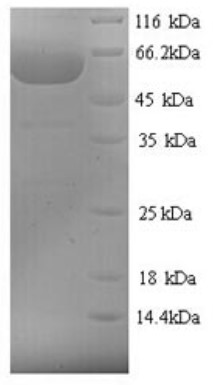PG
-
Official Full Name
Prostaglandin
-
Overview
A prostaglandin is any member of a group of lipid compounds that are derived enzymatically from fatty acids and have important functions in the animal body. Every prostaglandin contains 20 carbon atoms, including a 5-carbon ring. They are mediators and have a variety of strong physiological effects, such as regulating the contraction and relaxation of smooth muscle tissue.[1] Prostaglandins are not endocrine hormones, but autocrine or paracrine, which are locally acting messenger molecules. They differ from hormones in that they are not produced at a discrete site but in many places throughout the human body. Also, their target cells are present in the immediate vicinity of the site of their secretion (of which there are many). The prostaglandins, together with the thromboxanes and prostacyclins, form the prostanoid class of fatty acid derivatives, a subclass of eicosanoids. -
Synonyms
Prostaglandin; PG;
| Species | Cat.# | Product name | Source (Host) | Tag | Protein Length | Price |
|---|---|---|---|---|---|---|
| Human | PG-54H | Recombinant Human Prostate Specific Gene-1 | E.coli | His |
|
|
| Chamaecyparis obtusa | PG-5794C | Recombinant Chamaecyparis obtusa PG protein, His-tagged | Yeast | His | 51-514aa |
|
| Hinoki false-cypress | PG-4566H | Recombinant Hinoki false-cypress PG protein, His-SUMO-tagged | E.coli | His-SUMO | 51-514aa |
|
- Background
- Quality Guarantee
What is PG protein?
PG (rostate-Specific Gene-1) gene is a protein coding gene which situated on the long arm of chromosome 19 at locus 19q13. Human Prostate-Specific Gene-1 (HPG-1) product is a recently discovered membrane-anchored protein. It was detected exclusively in the prostate (19 different tissues were tested). Antisense-oligonicleotide inhibition of HPG-1 expression inhibited the growth of one prostate cancer cell line (LNCaP) significantly (86%). HPG-1 might be a novel diagnostic and/or therapeutic target.This protein is also called PG/PSA which is consisted of 237 amino acids and its molecular mass is approximately 28 kDa.
What is the function of PG protein?
PG is mainly secreted by prostate cells, and PG is a highly specific biomarker that can be used for screening and diagnosis of prostate cancer. Prostate cancer patients often have elevated PG levels in their blood. PG levels can also be used to assess the extent of prostate hyperplasia.
PG Related Signaling Pathway
PG can catalyze the synthesis of prostaglandins, thereby regulating prostaglandin levels. Prostaglandins are important bioactive substances involved in many physiological processes, including inflammation, vasodilation and smooth muscle contraction. PG has tissue kinase activity and is able to phosphorylate serine residues in substrate proteins, thereby affecting the activity of downstream signaling pathways. PG can affect cytoskeleton recombination and cell adhesion, thereby regulating cell movement and migration ability.
PG Related Diseases
Human prostate-specific Gene-1(HPG-1), a protein encoded by human prostate-specific antigen (PSA), has been linked to a number of Prostate diseases. Prostate cancer: PSA is a commonly used screening and diagnostic marker for prostate cancer. Prostate cancer patients often have elevated PSA levels in their blood. Prostatic hyperplasia: PSA levels can also be used to assess the extent of prostatic hyperplasia. Prostatitis: Prostatitis is an inflammation of the prostate tissue that can lead to elevated PSA levels. Male infertility: Some studies suggest that abnormal PSA levels may be associated with male infertility
Bioapplications of PG
It is a commonly used test marker to monitor the progression of related diseases or the prognosis of patients. For example, in the course of prostate cancer treatment, changes in PG levels can be used as an indicator of treatment effect. PG levels can also be used to assess the extent of prostatic hyperplasia.
High Purity

Fig1. SDS-PAGE (PG-5794C) (PROTOCOL for western blot)
PG involved in several pathways and played different roles in them. We selected most pathways PG participated on our site, such as , which may be useful for your reference. Also, other proteins which involved in the same pathway with PG were listed below. Creative BioMart supplied nearly all the proteins listed, you can search them on our site.
| Pathway Name | Pathway Related Protein |
|---|
PG has several biochemical functions, for example, . Some of the functions are cooperated with other proteins, some of the functions could acted by PG itself. We selected most functions PG had, and list some proteins which have the same functions with PG. You can find most of the proteins on our site.
| Function | Related Protein |
|---|
PG has direct interactions with proteins and molecules. Those interactions were detected by several methods such as yeast two hybrid, co-IP, pull-down and so on. We selected proteins and molecules interacted with PG here. Most of them are supplied by our site. Hope this information will be useful for your research of PG.
- Q&As
- Reviews
Q&As (7)
Ask a questionProstaglandins modulate immune cell function, impacting inflammation, cell-mediated immunity, and cytokine production.
Inhibiting prostaglandin synthesis can compromise gastric mucosal protection, increasing the risk of ulcers.
In the nervous system, prostaglandins are involved in pain transmission, mood regulation, and neuronal communication.
Prostaglandins contribute to cancer progression by promoting cell proliferation, angiogenesis, and evasion of immune responses.
Different prostaglandins modulate inflammation and pain by influencing enzyme activity, cytokine production, and receptor interactions.
Prostaglandins regulate blood pressure and vascular tone by affecting smooth muscle contraction and vasodilation.
In reproduction, prostaglandins are key in processes like ovulation, uterine contraction, and cervical dilation during labor.
Customer Reviews (3)
Write a reviewPrecise protein quantification services; crucial for our lab.
Great support for protein expression optimization; highly recommended.
Reliable antibody specificity; essential for immunoprecipitation studies.
Ask a Question for All PG Products
Required fields are marked with *
My Review for All PG Products
Required fields are marked with *


